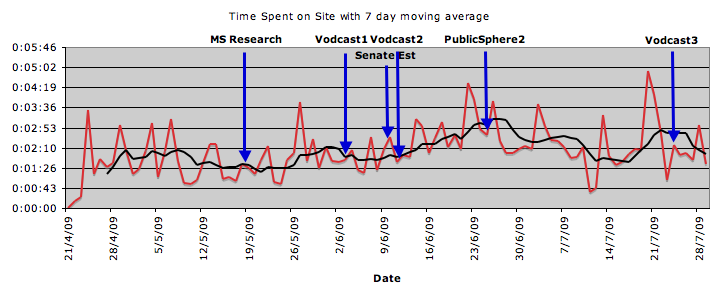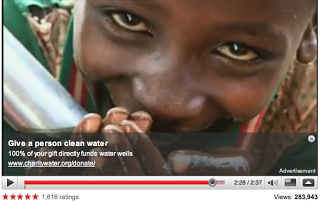We're very excited that Vquence and
Jimi Bostock
have together managed to snap one of the
round two projects
of the Australian Gov 2.0 Taskforce and that the project has a huge video focus - something that has (for valid reasons and yet disappointingly so) largely been treated as a side issue in Gov 2.0.
The project is about providing a scoping study for the potential of a video.gov.au site - something that we have promoted over the whole life of the Gov 2.0 Taskforce, since we see an enormous potential for online communication and engagement with the public through such a site. Also check out our
blog post on the Gov 2.0 Taskforce Website
.
Aside from the obvious advantages to the public, the idea is also to enable government agencies to be offered a technology solution for publishing video that is simple, solves the technical (bandwidth, reliability, scalability, player skinning etc) issues, and empowers them to publish more with less hassle. At the same time it should probably not force agencies to use a centralised solution, but only provide an optional service to them. If the service offers enough advantages, it will become popular all by itself.
But let's not jump to early conclusions: The first step in our work will be to analyse existing best practices in Australian and international government agencies and other organisations of a similar size.
Over the years we have seen many examples of video being used for news, educational purposes, marketing, documentation purposes, or simply to share great content. There is scope to publish old content, but even more potential with a continuous integration of video recordings and a video publications process with new activities.
Technical solutions for publishing video can range from:
-
creating the video player, hosting and video content management all from scratch,
-
using open source components for the video content management systems and the video player,
-
using hosted solutions provided by commercial entities,
-
to using social video networks for free or a small fee.
Often, we have seen organisations use more than one means of publishing video - a site-internal solution for the organisation and one or more social networking solutions to get the message out more easily. Different types of videos also lend themselves to different styles of publication - some are more prone to pick up attention on social networks than others.
Coming up with a recommendation that will suit all government agencies - from the small to the large - and still provide a central location at video.gov.au for citizens to go to and find government video is our challenge.
It will likely involve some kind of centralised hosting as well as feed aggregation. The latter is necessary to identify video hosted within social networks or by agencies themselves and is an interesting approach to mashing up.
The normalisation of meta data across different hosting solutions will likely be a challenge for a centralised solution, with centralised search being the one huge advantage over non-aggregated content.
In addition, a centralised video.gov.au can allow further engagement with the videos to happen then and there: comments, ratings, sharing on Facebook and Twitter, linking to other relevant videos are all things that are difficult to realise on distributed video.
Another huge opportunity is the creation of a centralised solution for accessibility: not just captions and subtitles, but also textual audio descriptions for the vision-impaired can be provided in a standard manner. This can be provided for centrally hosted or distributed video in the same manner. The ability to crowd source all this extra effort or find an automated solution has huge potential. Not to forget that such text will enable improved and deeper search, allowing to directly point to offsets in videos that are relevant to particular citizens.
Finally we should not forget that a centralised solution can also enable the consistent collection of statistics and monitoring of videos. Frequent reporting on the success of videos is a key enabler to determine the impact and success of the effort spent in this still very new field of public communication and engagement.
These are just some of our initial ideas about what we need to analyse as part of the scoping study.
Have we forgotten any aspects that you care about? Anything concerns you have about the scope of a video.gov.au? Anything that we should really look at when analysing existing best practice?
Feel free to leave comments or email us directly:
silvia.pfeiffer@vquence.com


Most commenters on YouTube are males between 13 and 27 years
Recently, we've been asked a lot about commenters on YouTube - it seems there is a large interest in finding out more about the engaged audience in videos. Our gut feeling was always that the majority of commenters were between 15 and 25. It is actually quite amazing how many immature and little useful comments you will find on YouTube - but occasionally you will also find some discussion gems between well-informed people. So, picking the gems amongst the noise is hard. But how hard?
Today we are approaching the answer to this question with an analysis of the demography of commenters on YouTube. For this, we have randomly picked 2,120 videos from YouTube, for which we found 36,459 comments. That's an average of roughly 17 comments per video, but note that this number doesn't mean much because the random 2,120 videos include ones that have no comments as well as ones with several thousands of comments. Since YouTube doesn't actually expose more than 1,000 comments per video, we had to limit the analysis of the comments per video to 1,000.
Out of the 36,459 randomly picked comments that were analysed 21,464 were by male commenters, 9,914 by female commenters. The remaining 5,081 commenters did not expose their gender.
Gender of commenters on YouTube
Even if all the commenters that did not expose their gender were female (which is unlikely) - the clear majority of commenters are male .
Now let's look at the age distribution. Out of the 36,459 randomly picked comments 26,668 provided their age. The distribution of ages is given in the next graph.
Age distribution of commenters on YouTube
The graph provides the exact age distribution as given by the commenters. Assuming they have all been truthful, we arrive at an a verage age of commenters of 27.59 years , i.e. the majority of commenters (namely 50.4%) are below 28 years of age.
Age distribution of commenters with 50% marked
Details of the distribution are found in this table:
Age distribution of commenters
Now, you will have noticed that out of the 36,459 randomly picked comments that were analysed, interestingly 326 declared to be over the age of 100 and the graph clearly spike for over 100 year-olds. We cannot easily make decisions about whether people have provided a misleading age or not, but for those over 100 it is a fair estimate to say that are incorrect. Since they create an unfair bias in the statistics, we also provide the analysis with ages above 100 removed.
Age distribution of commenters less than 100 years old
Now the average age of comment authors has come down to 26.6 and 52.93% of commenters are less than 27, 75% less than 36 years old.
The largest number of comments has been posted by 22 year old males (6.5%). As our initial gut feeling was the most commenters on YouTube are males between 15 and 25, this analysis has confirmed the gender and roughly the age group: the majority of commenters are between 13 and 27 years old.
We have no explanation for the weird shape of the graph which has a strong dip at 18 years and an unexpected peak at 29 years. This may well just be a problem with the small data set that we used, or there may be some fact to explain this. If you have any theories for these values, please leave a comment. We intend to undertake a broader analysis over more videos and comments in the future and may even be able to test your theories.